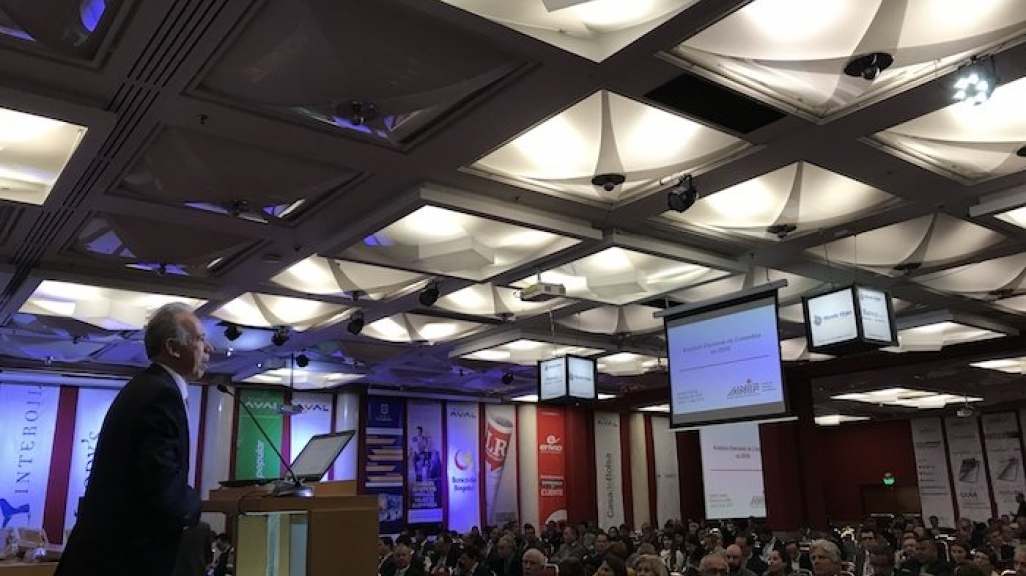#COLWallSt 2018 Recap: Colombia in the Eyes of Wall Street
#COLWallSt 2018 Recap: Colombia in the Eyes of Wall Street
Boosting growth, improving infrastructure, and increasing productivity: at AS/COA's Bogotá conference, participants discussed what lies ahead for Colombia's next president.
Lea una versión del resumen en español.
View the #ColWallSt discussion on Twitter.
“We couldn’t have arrived at a more relevant moment for the country,” said Adriana La Rotta, AS/COA’s senior director of media relations, as she kicked off “Colombia in the Eyes of Wall Street,” AS/COA’s twenty-second conference in Bogotá. An award-winning Colombian journalist, La Rotta acknowledged the debate fatigue Colombians feel ahead of the country’s presidential runoff on June 17, but she described the exchange of ideas between two distinct candidates as a sign of a vital democracy.
“The electoral cycle and democratic institutions in Colombia are viewed from the outside with admiration, at a moment in which democracy, not only in the American continent but in other places, is discredited and threatened,” said La Rotta.
In the conference’s first presentation, Leonardo Villar, the executive director of Fedesarrollo painted an economic landscape for Colombia and the broader world. He projected that Colombia’s GDP will grow 2.4 percent this year and 2.8 percent next year, and he noted that foreign direct investment increased 15 percent in 2017, hitting record highs in sectors other than petroleum and mining. While consumer confidence is at its highest level in the past two years, it remains on a downward trend. Villar said the next administration will face a number of economic challenges, including fiscal adjustments, sustainable growth, pension reform, and agricultural, mining, and petroleum development.
@Fedesarrollo Proyectamos un crecimiento de 2,4% para 2018 y 2,8% para 2019 #COLWallSt pic.twitter.com/x7XzVF7twq
— Fedesarrollo (@Fedesarrollo) June 13, 2018
Colombia’s Finance Minister Mauricio Cárdenas spoke next, offering an economic assessment of outgoing President Juan Manuel Santos’s administration. Cárdenas described the painful effect of an oil shock that led Colombia’s oil exports to decrease by 71 percent and government revenues in the industry to drop by 97 percent between 2013 and 2016. Since then, Colombia’s current account has returned to its pre-shock levels.
Cárdenas highlighted several achievements of the Santos administration, including the formal economy surpassing the informal economy, the country reaching its highest average economic growth since the 1970s, and Colombia’s recent admission as the 37th member of the Organization for Economic Cooperation and Development, which, he argued, will bring more investment to the country and lead to greater integration in the international financial community.
Ventajas de estar en la OCDE:
1. Adopción de buenas prácticas de los países con los mejores estándares.
2. Mayor inversión: inversionistas que sólo están en países OCDE.
3. “Carta de referencia” con otros países. #Anif #grupoaval pic.twitter.com/MvxwFarDOZ— J.A (@Raquelafanador) June 13, 2018
Following Cárdenas was the presentation of the Luis Carlos Sarmiento 2017–2018 Public Policy Research Award. Victor Saavedra accepted the award for Fedesarrollo’s report on the 10 steps Colombia must take to improve its educational outcomes by 2025. Saavedra named the quality of education as one of the most important indicators of a country’s success.
ANIF President Sergio Clavijo next gave a forecast for Colombia’s upcoming economic year. While Clavijo credited the Santos administration for navigating Latin America’s economic crisis, he said the rebound has been too modest and the country is not reaping the benefits of global macroeconomic growth. Additionally, he said Colombia is still highly dependent on commodities, and that sectors in whose recovery the administration invested the most, such as mining and construction, continue to be on the decline. Colombia has lost $20 billion in exports since 2012, a sign that the country must diversify its outward-bound trade. Clavijo echoed Villar’s concerns about consumer confidence, noting how Colombia’s consumer confidence index fell to 1.5 after maintaining an average of 10.9 in the preceding decade. Amid these reflections, Clavijo warned against anti-market populism that has taken hold in other parts of the world.
Conclusión: nos faltan USD$20.000 millones, y no los vamos a recuperar a punta de uchuvas y aguacates; NO se puede descuidar el sector minero-energético! - Sergio Clavijo en #COLWallSt @ASCOA @ANIFCO pic.twitter.com/0sCq7P8cmx
— Francisco Martinez (@kikomdzg) June 13, 2018
What is Wall Street looking for from the next Colombian administration? Realistic proposals, the ability to pass and implement reforms, and a focus on a swollen debt load and interest payments, said Moody’s Mauro Leos, opening the conference’s titular panel, “Colombia in the Eyes of Wall Street.” The debt load in particular hurt the country’s credit profile, said Leos, and caused the ratings agency to change its outlook from stable to negative earlier this year, while affirming the Baa2 investment-grade rating. “The equation is simple,” he said. “The bigger the debt load, the less room there is to make adjustments.” Next, Marcela Vaca of GeoPark highlighted how the company has been able to expand in Colombia, which represents 90 percent of the oil and gas company's production in Latin America. Citi’s Munir Jalil, echoing many of Leos’ points, stressed that international investors are looking for clear rules and a commitment to fiscal stability from the incoming government.
4G + P^2 + 2C
That's the equation for Colombia's future economic growth, says @MoodysLatAm's Leos.
4G = Infrastructure
P^2 = Peace processes
2C = Commodities + ConfidenceWatch his #COLWallSt presentation LIVE: https://t.co/1rgRu2FbT0
— Americas Society/Council of the Americas (@ASCOA) June 13, 2018
Los Colombianos tienen que entender que eventualmente vamos a tener un presidente de izquierda, queramos o no.
—Munir Jalil de @citicolombia en #COLWallSt— Americas Society/Council of the Americas (@ASCOA) June 13, 2018
The afternoon sessions focused on the big topic of the day: the 2018 electoral season, and the June 17 presidential runoff between Senator Iván Duque and former Bogotá Mayor Gustavo Petro. Clavijo mapped out the incoming congressional session, saying a newly formed coalition that includes members of both Álvaro Uribe and Juan Manuel Santos’ parties will control roughly three-quarters in both houses. Should Duque win as polls suggest, he’d have a honeymoon of governability of one or two years, said Clavijo, who then presented a quantitative analysis of which reforms would be most politically viable to pull off during those first years.
Sergio Clavijo: “La lista de prioridades para el próximo gobierno serán en el siguiente orden: i) ref. tributaria; ii) ref. laboral; iii) ref. justicia; y iv) ref. pensional”
Sigue EN VIVO la presentación de de seminario @ANIFCO, @ASCOA y @Fedesarrollo #COLWallSt pic.twitter.com/NQBmhvCw8S
— ANIF (@ANIFCO) June 13, 2018
While a Duque win was treated as a given for much of the day, Cifras y Conceptos’ César Caballero had one reminder for the room: “The probability that Petro wins [on June 17] is not 0 percent. And it’s higher than we’d think." The pollster noted that in the May 27 first round, the three center-left and left candidates garnered 9.84 million votes, more than 8.98 million received by the two center-right and right ones. And while Clavijo projected the null votes could reach as high as 10 percent on June 17, Caballero said his firm’s surveys found that number could approach 18 percent, or three times what is so far the highest null vote recorded in a Colombian presidential race since the turn of the century. Roberto Junguito, finance minister in the Betancur and Uribe administrations, gave a breakdown of how Duque and Petro administrations would respectively handle extractive industries, taxes, health care, and social security. The two candidates, said former Ambassador Fernando Cepeda, are alike in one important way: they’re both from the opposition, albeit from opposite ends of the spectrum. “The political consensus in Colombia is broken,” he said, and an important question in coming years is to figure out who will come to represent the new opposition.
Petro did one favor for the Colombian political establishment: he united it.
—Cepeda, closing out #COLWallSt with an analysis of #ColombiaDecide ahead of Sunday's presidential runoff.
— Americas Society/Council of the Americas (@ASCOA) June 13, 2018









